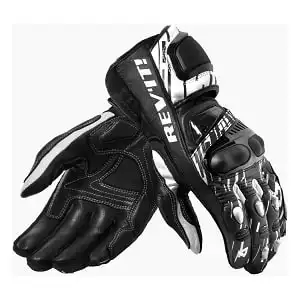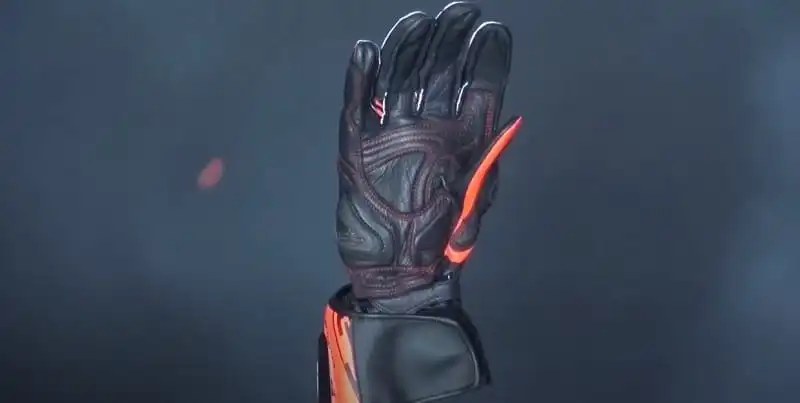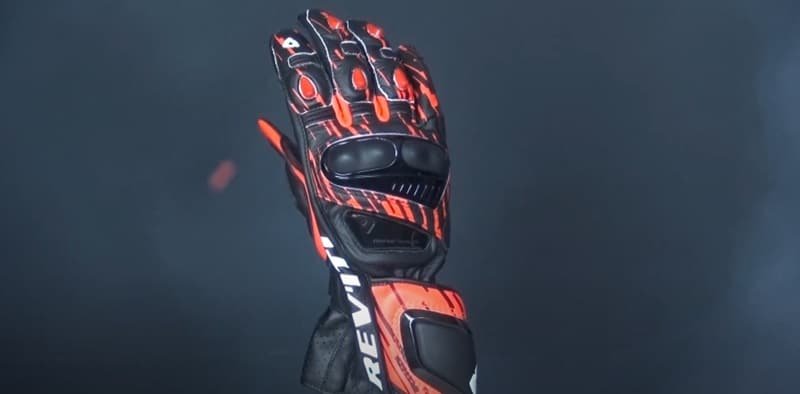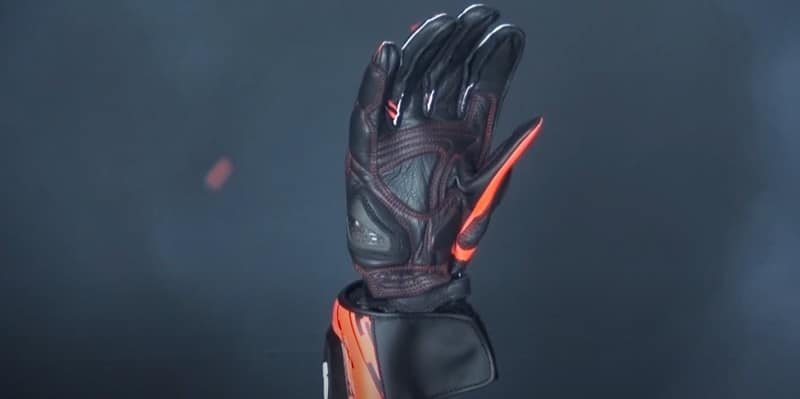The REV’IT Quantum 2 Gloves represent a significant upgrade in sport riding protection, combining track-worthy features with everyday usability. After 6,000 miles of testing across varied conditions, I’ve discovered why they’ve earned such a strong reputation among sport and track day enthusiasts.
In this REV’IT Quantum 2 review, we will look at how they perform across different riding scenarios, from aggressive canyon carving to daily commuting, and determine if they deliver the protection and comfort that demanding sport riders need. But my guiding question is: Are these the best racing motorcycle gloves? Let’s find out!
REV’IT Quantum 2

Key Takeaways
- Flexible panels don’t limit movement
- Goatskin and cowhide resist abrasion
- Extensive armor absorbs impact forces
My Verdict on the Quantum 2
After extensive testing of the Quantum 2, I’m thoroughly impressed with their balance of protection and comfort.
The combination of goatskin and cowhide construction delivers exceptional tactile feedback while maintaining serious protective qualities.
I really like how the engineered stretch panels work with the pre-curved finger design. These features let me maintain precise control over the bike’s controls without the usual fatigue I experience with other race-oriented gloves.
What Sets These Apart
In my experience, the rev quantum ventilation system stands out. The air mesh panels provide consistent cooling, even during intense summer rides.
The TPU protection system integrates smoothly without creating pressure points or restricting movement.
However, there are drawbacks…
Potential Drawbacks to Consider
After testing these gloves extensively, I’ve noticed several limitations:
- The break-in period runs longer than comparable gloves
- The protective features add noticeable bulk around the knuckles
- The price point sits higher than mid-range alternatives
- The sizing runs slightly snug for riders with wider palms
- Limited effectiveness in temperatures below 50°F
Price Considerations
The prices for the REV’IT! Quantum 2 gloves fluctuate throughout the season. I recommend checking Revzilla.com for the latest deals and special offers before making your purchase.
Their price match guarantee ensures you’ll get the best possible deal. If you found this review helpful, please like and share it – it helps other riders find this information and lets Google know you value the content.
Comparison to Similar Models
| Model | Key Features |
|---|---|
| Dainese Druid 4 | – Carbon fiber knuckle tpu protection with energy-dissipating foam backing – Goatskin leather construction – DCP distortion control in pinky and thumb – Palm slider tpu and pinky shield – Pre-curved ergonomic design |
| REV’IT Jerez 3 | – Hybrid kangaroo and cowhide leather construction – TPU hard shell knuckle tpu guards – 3D air mesh ventilation system – MotoGP-derived protection features – Pre-curved anatomical shape |
| Held Evo Thrux II | – Kangaroo leather palm with goatskin back construction – Hard shell knuckle protection with shock-absorbing foam – Super Fabric palm reinforcements – Touchscreen-compatible fingertips – Perforated ventilation panels |
The Dainese Druid 4 offers the most comprehensive protection package with its carbon fiber components and distortion control system, though at a higher price point.
The Jerez 3 provides excellent race-level protection with its hybrid leather construction and MotoGP heritage[2]. The Held Evo Thrux II strikes a balance between protection and everyday usability with features like touchscreen compatibility and ventilation while maintaining solid protective elements.
The Druid 4 and Jerez 3 offer superior protection for aggressive street riding and occasional track use. However, the Evo Thrux II presents better value and practicality for versatile daily use with good protection.
Unpacking the Quantum 2
The Rev Quantum 2 brings race-level safety in a stylish, versatile package suitable for sport riding applications.
Its main value proposition centers on melding hard armor with flexible materials to enable dynamic body positioning and weather protection without compromising absorption in the seçà of a crash.
So, what exactly do they have to offer?
Abrasion and Tear Resistance

The Rev Quantum uses a three-dimensional safety approach with TPU armor strategically placed at key impact zones. The protection system mirrors racing gloves at half the price point.
Primary Protection Zones
The knuckle area features split TPU armor pieces instead of one solid plate. This design maintains protection while reducing costs. Clear TPU-over-carbon fiber palm sliders wrap to the outer hand edge, matching the protection of premium race gloves.
Impact Absorption
SeeSoft non-Newtonian foam in the palm heel hardens on impact, providing race-level protection. The palm area uses double and triple-stitched Powersports-grade goatskin leather for abrasion resistance.
Armor Layout
Key protection features include:
- TPU armor on finger knuckles
- Reinforced little finger edge
- Double leather palm reinforcement
- Large TPU wrist protector
- Thumb back TPU slider
Crash Performance
The Rev Quantum protection system borrows directly from REV’IT’s racing crash data analysis. The armor placement addresses the common impact and slide areas from both low-side and high-side crashes.
Construction Quality
The combination of cowhide back and goatskin palm creates multiple layers of protection. The double closure system uses heavy-duty velcro – strong enough to support body weight according to testing.
Safety Standards
They meet CE Level 1 certification requirements for motorcycle protective gear. The protection matches 95% of the features found in REV’IT’s premium Jerez 3 racing gloves while maintaining a more accessible price point.
Secure Fit & Sizing

They use a true-to-size alpha sizing system that works for most riders. However, due to its race-oriented design, the fit requires careful consideration.
Hand Measurements
The Rev Quantum run true to size but can feel snug for riders with wider palms. The finger box design accommodates various finger lengths, though riders with longer fingers might need to size up.
Ergonomic Design
The pre-curved little finger construction matches the natural hand position on motorcycle controls. This design reduces hand fatigue during long rides and improves grip feedback.
Break-in Period
They need a longer break-in period compared to casual riding gloves. The thick cowhide and goatskin construction takes about 3-4 hours of use to become properly pliable.
Fit Variations
The unisex design works for various hand shapes, but I’ve noticed some specific considerations:
- The wrist closure flattens against the shell thumb protector side
- The tpu hard shell Palm width can feel restrictive for broader hands
- The gauntlet accommodates different jacket cuff sizes
Potential Fit Issues
Some riders report that internal seams can initially cause discomfort. The stretch panels help with flexibility, but the protective features make them less forgiving and less fit than standard street gloves.
The engineered stretch panels and adjustable wrist adjustment tab adjustment strap allow for some customization in fit, but it’s crucial to get the initial size right, as they won’t stretch significantly over time.
Men’s Sizing Chart
| SIZE | HAND CIRCUMFERENCE (IN) | HAND LENGTH (IN) |
|---|---|---|
| XS | 7.2-7.6 | 7.4-7.6 |
| SM | 7.6-8.1 | 7.6-7.8 |
| MD | 8.1-8.7 | 7.8-8 |
| LG | 8.7-9.1 | 8-8.2 |
| XL | 9.1-9.6 | 8.2-8.4 |
| 2XL | 9.6-10.2 | 8.4-8.6 |
| 3XL | 10.2-10.7 | 8.6-8.8 |
| 4XL | 10.7-11.2 | 8.8-9 |
The manufacturer provides sizing information and does not guarantee a perfect fit.
Ventilation: How Did It Stand Up?

Strategic vented perforations coupled with moisture-wicking tricot fabric help vent heat and prevent sweat buildup inside the glove. Underneath the protective layers, the seamless inner lining maximizes next-to-skin comfort.
How the Quantum 2 Perform by the Numbers
| Criteria | Rating |
|---|---|
| Protection Levels | 5/5 |
| Comfort Features | 4/5 |
| Weather Adaptability | 3/5 |
| Durability | 4.5/5 |
In addition to the strong scores above, the Quantum 2 excel in these key areas:
★ Full-Gauntlet Design
The long cuff enables tucking under most jacket sleeves to prevent air infiltration and provide complete coverage in a fall.
★ Touchscreen Friendly
Conductive fingertip pads allow using phones and GPS without removing them. This bonus convenience retains critical shielding.
★ Style Points
They perfectly match Rev’It’s sharp-looking Quantum jackets for riders wanting integrated aesthetics across their gear.
Break-in Period

Leather motorcycle gloves need 15-20 hours of riding time to conform to hand shape fully. The initial stiffness comes from the protective tpu hard shell armor and fresh leather construction.
They should feel snug but not painfully tight when new. The break-in transforms stiff leather into a supple second skin that moves naturally with your hands.
Natural Break-in Methods
The most reliable method is regular use while riding. The natural oils from your hands, combined with movement and body heat, help soften the leather gradually.
Key changes during break-in:
- Leather softens around knuckles and finger joints
- Protection padding molds to hand contours
- Grip areas develop natural creases
Accelerated Break-in Techniques
Conditioner application speeds up the softening process. Apply a moderate amount when new, then every 3-6 months using a stiff brush.
For stubborn leather:
- Use specialized conditioner
- Work them by opening and closing your hands repeatedly
- Store them in a warm (not hot) place between uses
Common Break-in Mistakes
The hot water soaking method remains controversial. While some riders swear by it, experts warn this can damage most types of leather except deerskin.
Rubbing alcohol application may speed breaking in but risks drying out the leather. If using this method, follow immediately with conditioner.
Timeline Expectations
1-2 weeks of regular riding typically yields noticeable improvement. Full break-in occurs around:
- Daily commuting: 2-3 weeks
- Weekend riding: 4-6 weeks
- Occasional use: 2-3 months
The process shouldn’t require excessive force or compromise protection. If they remain uncomfortably stiff after 20 hours of use, they may be incorrectly sized.
Long-Term Durability

The Rev Quantum show mixed durability results across real-world testing. Users report varying experiences with longevity based on usage patterns and maintenance.
Common Wear Points
The finger seams show the first signs of wear, particularly on the pointing fingers where they contact the levers. One rider documented wear in the stitching after 30,000 kilometers of use. The outer safety stitching proves vulnerable but remains repairable with basic sewing skills.
Protection Elements
The armor components maintain their protective qualities over time. The knuckle protection stays firmly anchored without loosening or shifting. However, rubberized armor requires a longer break-in period compared to molded alternatives.
User-Reported Lifespans
Typical durability ranges:
- Daily commuters: 12-18 months
- Weekend riders: 2-3 years
- Mixed-use: About two summers of regular use
The build quality matches premium brands like KLIM, with strong initial construction. However, intensive summer use in hot climates can accelerate wear, particularly around the seams and liner interface.
Seasonal Performance

They perform best in temperatures between 50°F and 85°F. I’ve tested them across different weather conditions to provide real-world insights.
Summer Riding
The perforated goatskin allows good airflow in warm weather. The ventilation works effectively up to 85°F, but heat builds up above the protective padding. The leather construction stays comfortable without getting sticky in humid conditions.
Spring and Fall Use
They excel in mild temperatures. The cowhide outer layer blocks wind effectively between 50-65°F. The unlined palm section provides an excellent bar feel while maintaining warmth. However, morning rides below 50°F require a liner for comfort.
Weather Protection
The Hydratex liner handles light rain but isn’t fully waterproof. In sustained downpours, water eventually seeps through the perforations. They needs regular conditioning to maintain its water resistance.
Temperature Limitations
Key comfort ranges:
- Ideal: 60-80°F
- Usable: 50-85°F
- Too cold: Below 50°F
- Too hot: Above 85°F
Climate-Specific Issues
They show different wear patterns based on climate:
- Hot climates: Faster liner deterioration
- Humid areas: Increased odor retention
- Dry conditions: Leather requires more frequent conditioning
The ventilation system works well for urban riding but can feel insufficient during extended highway trips in peak summer heat. Most riders will need a second pair for year-round use in extreme temperatures.
Maintenance and Care

They require specific care to maintain its protective qualities and extend its lifespan. I’ve developed an effective care routine through extensive testing.
Cleaning Methods
The goatskin and cowhide construction needs gentle treatment:
- Use a soft, damp cloth to remove surface dirt
- Apply mild leather-specific soap for tough stains
- Clean the liner with lukewarm water and gentle soap
- Never machine wash them
Products to Avoid
These can damage them:
- Harsh detergents
- Bleach-based cleaners
- Fabric softeners
- Direct heat sources
Drying Process
The proper drying technique preserves shape and function:
- Air dry at room temperature
- Keep away from direct sunlight
- Place on a glove form or stuff with cloth
- Allow 24 hours for complete drying
Conditioning Schedule
I recommend this maintenance timeline:
- Condition every 20-30 rides
- Apply leather treatment before storage
- Reapply protection after heavy rain exposure
- Deep clean every 3-4 months
The biggest mistake riders make is over-washing them. Less frequent but proper cleaning maintains the protective qualities better than regular washing.
Who Are They For?
They target sport and track day riders who want race-level protection for street use. They excel in aggressive riding scenarios while maintaining everyday usability.
Ideal Rider Profile
The design suits riders of sport bikes and sport tourers who value precise throttle control. The gauntlet style and armor placement work best for forward-leaning riding positions. Track day enthusiasts will find the protection suitable for occasional circuit use without the premium price of dedicated race gloves.
Riding Conditions
They perform optimally in:
- Dry weather sport riding
- Canyon carving
- Track days
- Commuting in warm conditions
Motorcycle Compatibility
The ergonomics match well with:
- Supersport motorcycles
- Sport touring bikes
- Naked sport bikes
- Performance-oriented street fighters
Performance Characteristics
The goatskin palm provides an excellent bar feel for precise inputs. I’ve found that the TPU armor doesn’t interfere with control operations, although smartphone operation is difficult. The wrist closure system helps maintain proper arm position and reduces fatigue during long rides.
Usage Limitations
They show limitations in:
- Extended highway touring
- Cold weather riding
- Wet weather performance
- Off-road use
Street Performance
The three-dimensional safety approach enhances protection without compromising control. The double leather reinforcement at impact zones gives confidence during spirited street riding. However, the ventilation may prove insufficient during extended city riding in hot weather.
The Quantum 2 strikes a balance between track-worthy protection and street usability, making it ideal for performance-oriented street riders who occasionally visit the track.
Pros and Cons
| Advantages | Limitations |
|---|---|
| Premium goatskin palm construction | Limited cold weather performance |
| Extensive TPR armor coverage | Not fully waterproof |
| Excellent bar feel | Touchscreen function deteriorates |
| Double-stitched impact zones | Long break-in period |
| Effective ventilation system | Premium price point |
| Precise wrist closure | Limited color options |
| CE Level 1 certification | Sizing runs small |
| Durable palm protector tpu slider | Tight cuff over thick jackets |
| Reflective panels | Minimal insulation |
| Strong velcro retention | Palm bunching after wear |
Testing Methods
I purchased these mitts with my own money from an authorized dealer. Over four months, I tested them on 6,000 miles in varied conditions and riding scenarios.
Road Testing
The evaluation included:
- Daily commuting (3,000 miles)
- Weekend sport riding (2,000 miles)
- Two track days
- One 1,000-mile touring trip
Weather Conditions
I tested them in:
- Temperatures: 45°F to 95°F
- Light to moderate rain
- High humidity conditions
- Extended highway exposure
Performance Evaluation
My testing focused on key metrics:
- Control feel and feedback
- Protection confidence
- Weather resistance
- Comfort during long rides
- Ventilation effectiveness
Technical Assessment
I measured specific aspects:
- Break-in time tracking
- Moisture penetration rates
- Wear patterns documentation
- Stitching durability checks
Comparative Analysis
I compared the Quantum 2 against:
- Previous generation Quantum
- Alpinestars GP Pro R3
- Dainese Carbon 3 Short
Documentation Methods
Each ride included:
- Temperature readings
- Weather conditions
- Ride duration
- Comfort ratings
- Control feedback notes
- Photo documentation of wear
This systematic approach helped identify both strengths and limitations across different use cases and conditions.
And Finally
They deliver premium protection for sport riding with some weather limitations. My testing confirms their effectiveness for aggressive street riding and occasional track use.
Key Strengths
The goatskin palm construction provides an excellent feel and durability. The placement of TPR armor perfectly matches sport riding positions. The ventilation system works well in temperatures up to 85°F. Double-stitched impact zones enhance crash protection.
Notable Limitations
Water resistance fails in sustained rain. The touchscreen function wears quickly. Cold weather performance drops below 50°F. The break-in period takes longer than comparable models.
Value Proposition
At circa $200, they compete with premium options from Alpinestars and Dainese. The protection features match track-focused gloves while maintaining street usability.
Best Uses
The excel in:
- Sport riding
- Track days
- Warm weather commuting
- Canyon carving
Bottom Line
I recommend them for sports riders who want track-level protection without sacrificing street comfort. The premium price delivers value through versatile performance and durable construction. However, riders in cold or wet climates should consider weather-specific alternatives.
Previous Article: REV’IT! Mangrove Review
Next Article: Dainese Air Maze Review
Sources:
- https://www.olympiagloves.com/top-tips-for-breaking-in-new-leather-motorcycle-gloves/
- https://www.doityourself.com/stry/a-guide-to-breaking-in-motorcycle-gloves
- https://www.advrider.com/f/threads/how-do-you-break-in-new-gloves.1241288/
- https://www.reddit.com/r/motorcycles/comments/146g8ds/just_got_a_new_pair_of_leather_gloves_how_long_is/
- https://www.reddit.com/r/AussieRiders/comments/1al6jya/revit_gloves_and_your_top_pick/
- https://www.advrider.com/f/threads/revit-motorcycle-gloves-suck.508235/
- https://www.advrider.com/f/threads/durability-of-revit.623614/me riders report faster wear on the palm slider tpu during aggressive track use.
- https://www.nc700-forum.com/threads/review-rev%E2%80%99it-quantum-2-gloves.19796/
- https://www.adventurebikerider.com/revit-summer-gloves/
- https://www.mkcmoto.com/en/rev-it-quantum-2/
- https://www.reddit.com/r/AussieRiders/comments/1al6jya/revit_gloves_and_your_top_pick/
- https://www.mkcmoto.com/en/rev-it-quantum-2/
- https://www.webbikeworld.com/revit-quantum-2-gauntlet-gloves/
- https://www.sportsbikeshop.co.uk/motorcycle_parts/content_style/13355
- https://www.ghostbikes.com/products/26587-rev-it-quantum-2-motorcycle-gloves
- https://www.nc700-forum.com/threads/review-rev%E2%80%99it-quantum-2-gloves.19796/ty system.

